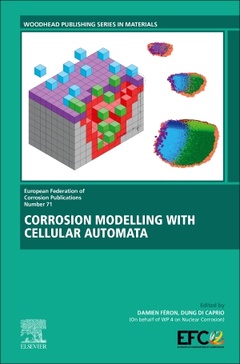Corrosion Modelling with Cellular Automata European Federation of Corrosion (EFC) Series

Corrosion Modelling with Cellular Automata bridges the gap between finer scales based on atomic physics and the larger-scale based on physico-chemical properties of materials and their environments. The book describes the simulation and modeling of corrosion phenomena by cellular automata and underlines the collaborative and interdisciplinary relationships that underpin them. It explores the major achievements that have been performed to date, covers basic knowledge on cellular automata and corrosion phenomena, and includes sections on CA modeling of generalized and uniform corrosion in 2D and 3D under various conditions, including aqueous environments and high temperature processes.
Finals sections present examples on the use of cellular automata for modeling localized corrosion as well as recent developments on intergranular corrosion. There is also a review on the use of CA for modeling pitting corrosion.
Part I INTRODUCTION 1. Corrosion Basis 2. Cellular automata modelling applied to corrosion
Part II GENERALIZED CORROSION 3. 2D and 3D Numerical Simulation of High-Temperature Corrosion Processes by Means of the Cellular Automata Approach 4. Cellular automata model of aqueous corrosion 5. A cellular automaton paint to study the release of active corrosion inhibitors from primers
PART III LOCALIZED CORROSION 6. Cellular automaton modelling of intergranular corrosion of non-sensitized austenitic stainless steels 7. Estimation of Intergranular Corrosion Rate of Stainless Steel Using Cellular Automata Considering Stochastic Process 8. Cellular automata simulation of pitting corrosion of metals: A review
DI CAPRIO Dung is currently working as a researcher “Hors Classe at CNRS in the Institute of Research of Chimie Paris (IRCP). He graduated from the “Ecole Normale Supe´rieure de Lyon in 1990 and then went on to obtain his Ph.D in Theoretical Physics on “the study of critical phenomena in liquids from the University of Paris VI. His research interests include modelling of complex systems at interfaces: electrical double layer, and nematic fluids using a statistical mechanics-based approach.
He also develops numerical simulations to study electrodeposition, corrosion and passivation phenomena using a cellular automata approach. He has published over 80 scientific papers
- Focuses on the use of cellular automata for modeling corrosion
- Covers recent advances in modeling generalized corrosion with cellular automata
- Illustrates how cellular automata can be used to model localized corrosion (pitting and intergranular corrosion)
- Spans various length scales from atomistic to mesoscale
Date de parution : 03-2024
Ouvrage de 208 p.
15x22.8 cm
Thème de Corrosion Modelling with Cellular Automata :
Mots-clés :
Simulation; metals; alloys; monitoring; protection; education; mechanisms; quantification; prediction
